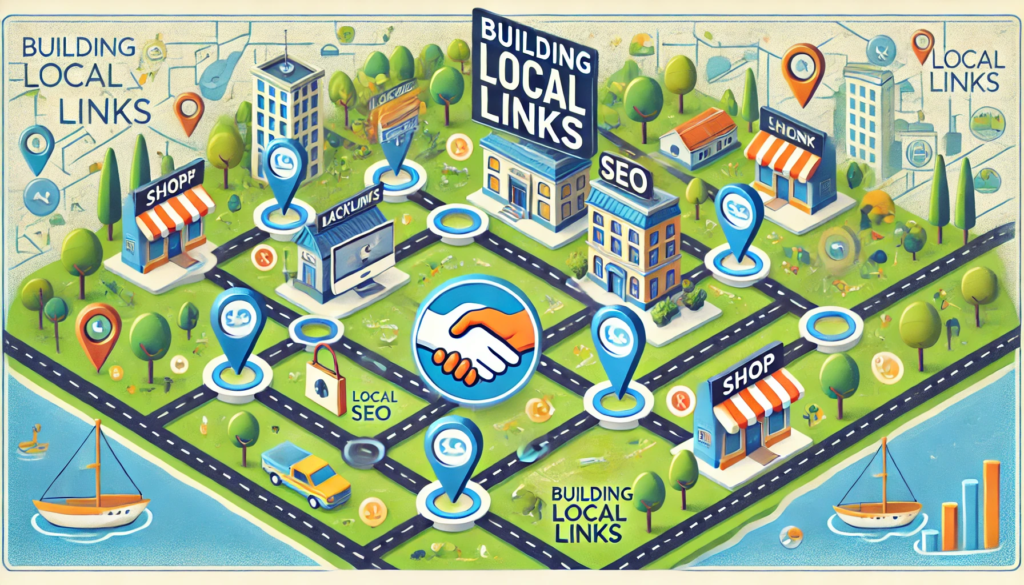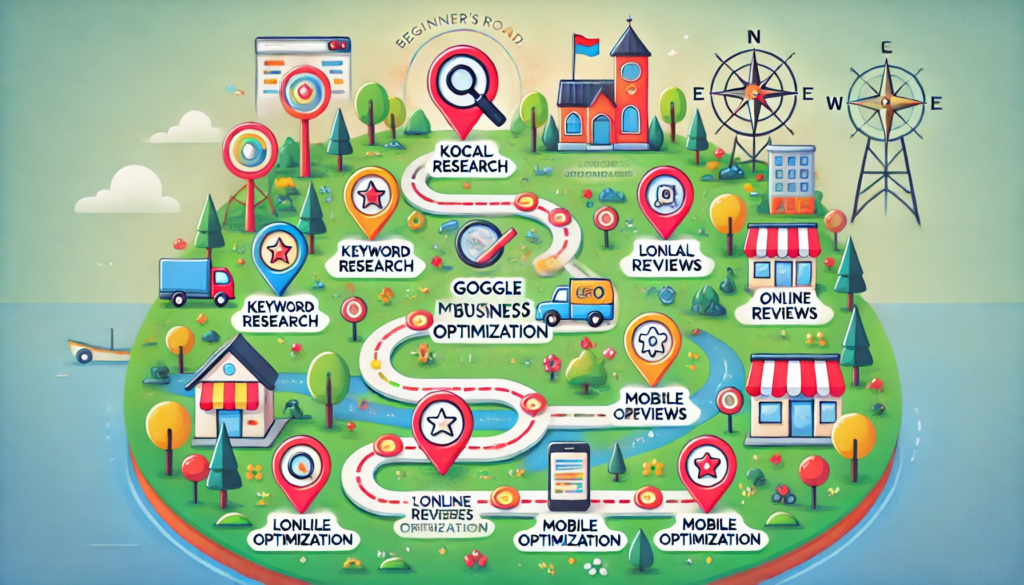In today’s digital-driven world, businesses must establish a strong online presence to remain competitive. Local SEO (Search Engine Optimization) is an essential strategy for small and local businesses aiming to attract customers in their immediate geographic area. This roadmap will guide you through the basics of Local SEO, helping you understand how to optimize your online presence and stand out in local search results.
Table of Contents
What are Local SEO Techniques?
Local SEO is a branch of search engine optimization that focuses on optimizing a business’s online presence to attract more local customers. Unlike traditional SEO, which prioritizes rankings on a global or national scale, Local SEO targets location-based searches. For instance, a query like “best pizza near me” or “plumber in [city]” triggers search results specifically tailored to the user’s geographic location.
By leveraging Local SEO techniques, businesses can improve their visibility in local search results, which typically include Google’s Local Pack (the map and list of businesses), organic search results, and even voice searches. Whether running a retail store, a service-based business, or a local consultancy, Local SEO is critical to reaching nearby customers.
Why Does Local SEO Matter?
Increased Visibility
Local SEO enhances your business’s visibility in search results, making it easier for nearby customers to discover your products or services.
Targeted Traffic
Unlike general SEO, Local SEO attracts highly targeted traffic. Potential customers searching for local services are often closer to the bottom of the sales funnel and ready to purchase.
Builds Trust
When your business appears in the Local Pack or has positive reviews on local directories, it builds consumer credibility and trust.
Mobile Search Growth
The rise of smartphones has led to an increase in local searches. Terms like “near me” and “open now” are frequently searched by users on the go. Optimizing for Local SEO ensures your business is in front of this mobile-savvy audience.
Key Components of Local SEO
Businesses must focus on several key elements to optimize for Local SEO. Here’s a breakdown of the essential components:
1. Google Business Profile Optimization
Google Business Profile (GBP), formerly known as Google My Business, is a free tool provided by Google to help businesses manage their online presence.
How to Optimize Your GBP:
- Claim and Verify Your Listing: Visit the Google Business Profile page to claim your business and complete the verification process.
- Complete All Fields: Ensure all details, including your business name, address, phone number (NAP), website URL, operating hours, and categories, are accurate and consistent.
- Add High-Quality Images: Include photos of your storefront, products, and team. Visuals create a strong first impression.
- Use Keywords in Your Description: Write a concise, keyword-rich description highlighting your services.
- Encourage Reviews: Ask satisfied customers to leave positive reviews. Responding to reviews (both positive and negative) shows you value customer feedback.
- Enable Messaging: Turn on messaging through your GBP profile to allow customers to contact you directly.
2. Optimize for Local Keywords
Keyword research is a foundational element of SEO, and for Local SEO, targeting location-specific keywords is vital.
Steps to Find Local Keywords:
- Use Keyword Tools: Platforms like Google Keyword Planner, Ahrefs, or SEMrush can help identify relevant terms.
- Incorporate Geographic Modifiers: Combine your primary keywords with location-based terms, such as “florist in Chicago” or “landscaping services Los Angeles.”
- Analyze Competitors: Look at the keywords your competitors use that rank high in local searches.
Where to Use Keywords:
- Page titles and meta descriptions
- Headings (H1, H2, etc.)
- Content body
- Alt text for images
- URLs and anchor text
3. NAP Consistency
NAP stands for Name, Address, and Phone Number. Consistent NAP information across all online platforms ensures that search engines and potential customers trust your business.
Tips for NAP Consistency:
- Use the same formatting for your business name, address, and phone number across all directories, websites, and social media platforms.
- Avoid abbreviations or variations that could confuse search engines.
- Regularly audit your citations to ensure accuracy.
4. Local Citations
Local citations are online mentions of your business information on directories, websites, or social platforms. These citations signal your business’s legitimacy to search engines.
Popular Citation Sources:
- Google Business Profile
- Yelp
- Yellow Pages
- Bing Places
- TripAdvisor
- Local Chamber of Commerce websites
Ensure your NAP details are accurate on all these platforms, and avoid duplicate listings.
5. Mobile Optimization
Since a significant portion of local searches are conducted on mobile devices, optimizing your website for mobile users is crucial.
Mobile Optimization Best Practices:
- Use a responsive design to ensure your website displays well on all screen sizes.
- Optimize page load speed to prevent users from bouncing.
- Ensure buttons and links are easy to click on smaller screens.
- Include click-to-call functionality for quick access to your business.
On-Page SEO for Local Search
On-page SEO involves optimizing your website to rank higher in local search results. Here are the core areas to focus on:
1. Title Tags and Meta Descriptions
Craft engaging title tags and meta descriptions that include your target keywords and geographic modifiers. These elements play a significant role in attracting clicks.
2. Header Tags
Organize your content using structured header tags (H1, H2, H3). Incorporate local keywords naturally within these headers.
3. Location Pages
Create dedicated pages for each city or region if your business serves multiple locations. Each page should include:
- A unique title and meta description
- Localized content
- Embedded Google Maps
- Customer testimonials specific to the area
4. Schema Markup
Schema markup is a form of microdata that provides search engines with additional context about your business. Use local business schema to highlight information such as:
- Address
- Phone number
- Business hours
- Customer reviews
Tools like Google’s Structured Data Markup Helper can simplify this process.
Building Local Links

Link building remains a critical factor for SEO success. For Local SEO, the focus should be on acquiring links from locally relevant and authoritative sources.
Ways to Build Local Links:
- Sponsor Local Events: Partner with local events or charities to earn backlinks from their websites.
- Collaborate with Local Bloggers: Reach out to local influencers or bloggers for guest posting opportunities.
- Join Local Business Associations: Membership often includes a listing on their website with a backlink.
- Create Hyperlocal Content: Write blog posts or guides about your community, highlighting local landmarks, events, or news.
Leverage Online Reviews
Online reviews significantly influence consumer decisions and play a role in Local SEO rankings. Encourage customers to leave reviews on platforms like Google, Yelp, and Facebook.
Best Practices for Reviews:
- Respond promptly to reviews, whether positive or negative.
- Avoid fake or incentivized reviews; authenticity is key.
- Use reviews as an opportunity to address customer concerns and improve your services.
Voice Search and Local SEO
Voice search is growing in popularity, especially for local queries like “Where’s the nearest gas station?” or “Who delivers pizza around here?” To optimize for voice search:
- Use natural, conversational language in your content.
- Answer frequently asked questions about your business.
- Focus on long-tail keywords and question-based phrases.
Tracking and Measuring Local SEO Success
Regularly monitoring your Local SEO efforts is essential to ensure you’re on the right track. Here are some tools to help you analyze your performance:
1. Google Analytics
Track traffic, user behavior, and conversion rates on your website.
2. Google Search Console
Monitor your website’s performance in search results, including impressions, clicks, and keyword rankings.
3. Rank Tracking Tools
Platforms like BrightLocal, Moz, or SEMrush can help you track your local keyword rankings.
4. Customer Feedback
Monitor reviews and direct customer feedback to identify areas for improvement.
Conclusion
Local SEO is an indispensable strategy for businesses aiming to attract and retain customers in their geographic area. By optimizing your Google Business Profile, targeting location-specific keywords, ensuring NAP consistency, and building local links, you can improve your visibility and stand out in local search results. Combined with ongoing monitoring and adjustments, these strategies will help your business thrive in the competitive local market.
Start implementing these tips today to ensure that your business is not just part of the local search landscape but a leader in it.



